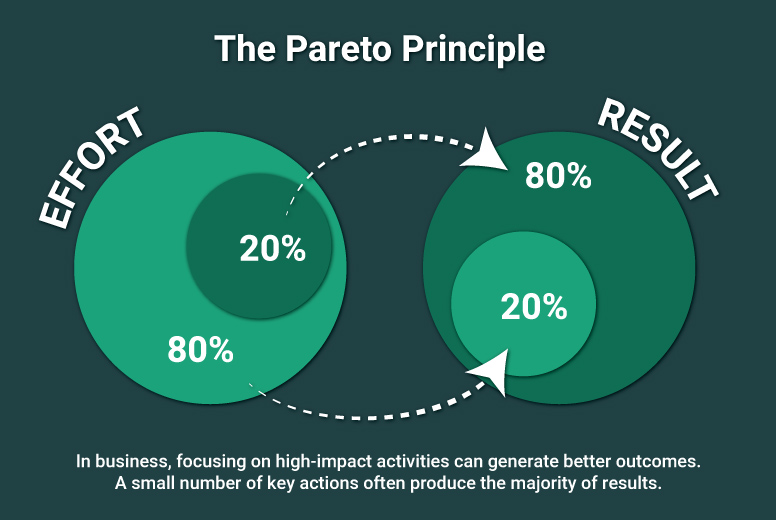How to Leverage the Pareto Principle: Time Allocation Tactics for Maximum Impact


Introduction
In the fast-paced world of business, time is our most valuable resource. However, it's not always easy to allocate our time effectively and efficiently. This is where the Pareto Principle comes in. Also known as the 80/20 rule, the Pareto Principle states that 80% of the results come from 20% of the efforts. By understanding and leveraging this principle in time management, you can maximize your impact and productivity.
Overview of the Pareto Principle and its significance in time management
The Pareto Principle is named after Italian economist Vilfredo Pareto, who first observed the unequal distribution of wealth in society. This principle suggests that a small percentage of inputs or actions lead to a large percentage of outputs or results. In the context of time management, it means that focusing on the critical few tasks or activities that yield the most significant results can make a huge difference in overall productivity.
By identifying the 20% of tasks that contribute to 80% of your desired outcomes, you can prioritize and allocate your time accordingly. This allows you to eliminate time-wasting activities and focus on the high-impact tasks that will bring the most value to your business and personal life.
Understanding the 80/20 rule and its application to time allocation
The 80/20 rule indicates that not all tasks or activities are created equal. In fact, a small fraction of your efforts will generate the majority of your desired results. By analyzing your tasks and identifying the few actions that contribute the most to your goals, you can prioritize them and allocate more time and resources to them. This way, you ensure that you are investing your time in the activities that will yield the greatest returns.
To apply the 80/20 rule to time allocation, start by identifying the key tasks or activities that align with your goals and have the highest impact. This could involve analyzing past performance data, customer feedback, or expert advice. Once you have identified these tasks, schedule dedicated time blocks for them and eliminate or delegate lower-value tasks. By consistently focusing on the critical few, you can accomplish more in less time.
Best examples
Many successful individuals and companies have leveraged the Pareto Principle to achieve exceptional results. For example, Apple's product development strategy follows the 80/20 rule by prioritizing a small number of key features that have the most impact on user experience. Similarly, successful entrepreneurs often identify and focus on the few revenue-generating activities that drive the most significant growth for their businesses.
In personal life, applying the Pareto Principle may involve identifying the 20% of activities that bring you the most joy, fulfillment, or personal growth. By dedicating more time and attention to these activities, you can enhance your overall happiness and well-being.
In conclusion, the Pareto Principle can be a game-changer in time management. By prioritizing the critical few tasks or activities that generate the most significant results, you can optimize your time allocation and maximize your impact. Whether in business or personal life, leveraging the 80/20 rule can lead to greater productivity, efficiency, and success.
Identify Your Priorities
Assessing and prioritizing your tasks and responsibilities
To effectively leverage the Pareto Principle for maximum impact in time management, it is essential to assess and prioritize your tasks and responsibilities. Start by listing all the tasks and responsibilities you need to accomplish, whether in your business or personal life. This comprehensive list will serve as a starting point for identifying the critical few that contribute the most to your desired outcomes.
Take a moment to evaluate each task and determine its significance in relation to your goals. Consider the potential impact each task will have on achieving your desired results. This assessment will help you identify the tasks that should be prioritized to ensure maximum efficiency and productivity.
Determining the most important activities for maximum impact
Once you have assessed your tasks and responsibilities, it's time to determine the most important activities that will have the greatest impact on your desired outcomes. Look for the tasks that align directly with your goals and can produce significant results. These tasks are the ones that deserve the majority of your time and attention.
Consider the 80/20 rule and focus on the tasks that fall within the critical 20%. These are the tasks that will generate the majority of your desired outcomes. By dedicating more time and resources to these activities, you can optimize your time allocation and achieve maximum impact.
Eliminate or delegate tasks that are low-value or do not contribute significantly to your goals. This will free up more time and energy to invest in the high-impact activities.
Remember, effective time allocation requires discipline and a clear understanding of your priorities. By consistently focusing on the tasks that matter the most, you can make significant strides towards your goals and achieve greater success in both your business and personal life.
Delegate and Outsource
Recognizing tasks that can be delegated or outsourced
When it comes to leveraging the Pareto Principle for time allocation, recognizing tasks that can be delegated or outsourced is key. Take a close look at your task list and identify any activities that can be effectively handled by someone else. These could be tasks that are repetitive, time-consuming, or require specific expertise that you may not possess.
Start by assessing your own strengths and weaknesses. Determine which tasks align with your core competencies and should be prioritized for your direct involvement. For tasks that fall outside your area of expertise or have a lower priority, consider whether they can be delegated to someone else within your organization or outsourced to a reliable third party.
Effective strategies for delegating and outsourcing effectively
Delegating and outsourcing tasks can be a game-changer in maximizing your time and impact. Here are some effective strategies to ensure smooth delegation and outsourcing:
Clearly define expectations: When delegating or outsourcing a task, clearly communicate your expectations, desired outcomes, and any specific guidelines or instructions. This will help the person or team taking on the task to understand what needs to be done and deliver accordingly.
Provide necessary resources: Ensure that the individuals or external partners have access to the resources they need to successfully complete the task. This includes providing relevant information, tools, and any required training or support.
Regularly communicate and provide feedback: Stay connected with the individuals or teams handling the delegated or outsourced tasks. Regularly communicate to check progress, offer guidance if needed, and provide feedback as the work progresses.
Trust and empower: Trust the capabilities of the individuals or external experts you have delegated or outsourced tasks to. Empower them to make decisions within their area of responsibility. This not only fosters a sense of ownership but also allows you to focus on higher-priority activities.
By recognizing the tasks that can be delegated or outsourced and implementing effective strategies, you can free up your time to concentrate on tasks that require your unique expertise, ultimately maximizing your impact and productivity.
Eliminate Time-wasting Activities
When it comes to maximizing your impact and productivity, it's essential to leverage the Pareto Principle and allocate your time wisely. One of the key tactics to achieve this is by identifying and eliminating activities that do not contribute to your goals. Here, we will explore how you can leverage the Pareto Principle to eliminate time-wasting activities and minimize distractions for improved productivity.
Identifying and Eliminating Activities that Do Not Contribute to Your Goals
Start by evaluating your task list and identifying activities that do not align with your goals or priorities. These could be tasks that are time-consuming, repetitive, or have minimal impact on your overall objectives. By recognizing these activities, you can eliminate or delegate them to free up valuable time.
Minimizing Distractions and Time-wasters for Improved Productivity
In today's digital age, distractions are everywhere, and they can significantly impact your productivity. To minimize these distractions, consider implementing the following strategies:
Set clear boundaries: Establish dedicated work hours and create a distraction-free work environment. Communicate these boundaries to your team or colleagues to ensure uninterrupted focus.
Prioritize your tasks: Use the Pareto Principle to identify the 20% of tasks that contribute to 80% of your desired outcomes. Prioritize these high-impact tasks and allocate focused time for their completion.
Limit multitasking: Avoid working on multiple tasks simultaneously as it can lead to decreased productivity and reduced quality of work. Focus on one task at a time and give it your full attention.
Avoid unnecessary meetings: Evaluate the necessity of every meeting and decline invitations that do not require your direct involvement. Opt for alternative communication methods such as emails or quick updates.
By identifying and eliminating activities that do not contribute to your goals, as well as implementing strategies to minimize distractions, you can allocate your time effectively and maximize your impact on the tasks that truly matter.
Focus on High-Value Activities
When it comes to achieving maximum impact and productivity, it's crucial to focus on high-value activities. The Pareto Principle, also known as the 80/20 rule, suggests that 20% of your efforts yield 80% of the results. By identifying and prioritizing these high-value activities, you can allocate your time and resources more effectively to maximize your impact. Here, we will explore how to leverage the Pareto Principle for time allocation tactics that yield the greatest results.
Identifying high-value activities that yield the greatest results
To identify high-value activities, start by evaluating your task list and assessing the potential impact of each task. Consider the following factors:
- Urgency: Is the task time-sensitive or critical to the achievement of your goals?
- Importance: Does the task contribute significantly to your desired outcomes?
- Potential ROI: Will the task generate a high return on investment in terms of time, effort, or resources?
By analyzing these factors, you can prioritize activities that align with your goals and have the potential to yield the greatest results.
Tips for organizing and prioritizing high-value tasks
To prioritize high-value tasks effectively, consider the following tips:
- Create a task list or schedule: Organize your tasks in a way that allows you to visually see their importance and deadlines.
- Use time-blocking techniques: Allocate specific time blocks for high-value activities to ensure uninterrupted focus and productivity.
- Delegate or outsource: Identify tasks that can be delegated to others, freeing up your time for higher-value activities.
- Continuously reassess priorities: Regularly review your task list to ensure that you are focusing on the most important and impactful activities.
By effectively identifying and organizing high-value tasks, you can allocate your time and energy to activities that yield the greatest results, ultimately boosting your productivity and success.
Conclusion
In conclusion, leveraging the Pareto Principle for time allocation can greatly enhance your productivity and maximize your impact. By focusing on high-value activities, you can ensure that you are allocating your time and resources effectively.
Summarizing the benefits of leveraging the Pareto Principle in time allocation
Efficient use of time: By identifying and prioritizing high-value activities that yield the greatest results, you can allocate your time more efficiently. This allows you to focus on tasks that contribute significantly to your desired outcomes.
Increased productivity: By dedicating more time to high-value activities, you can maximize your productivity. This means that you are spending your time and energy on tasks that have a high return on investment in terms of time, effort, or resources.
Improved goal alignment: Prioritizing high-value activities ensures that you are aligning your efforts with your goals. You are able to work towards objectives that have the potential to yield the greatest results and contribute significantly to your desired outcomes.
Final thoughts and tips for maximizing productivity through effective time management
To maximize productivity through effective time management and leverage the Pareto Principle, consider the following tips:
Continuously reassess priorities: Regularly review your task list and reassess your priorities to ensure that you are focusing on the most important and impactful activities.
Eliminate or delegate low-value tasks: Identify tasks that are not contributing significantly to your desired outcomes and consider eliminating or delegating them. This frees up your time for higher-value activities.
Streamline processes: Look for ways to streamline your processes and eliminate any unnecessary steps or inefficiencies. This can help you save time and focus on the tasks that truly matter.
By implementing these strategies and leveraging the Pareto Principle, you can effectively allocate your time and energy for maximum impact and productivity. Remember, it's not about doing more tasks, but doing the right tasks that yield the greatest results.



